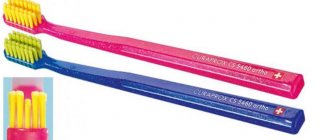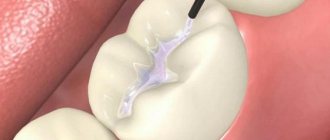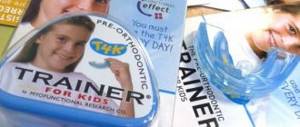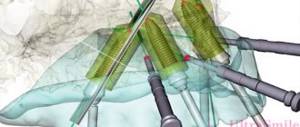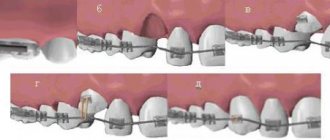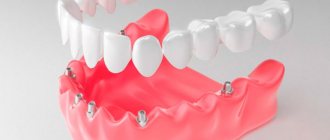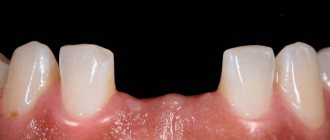4110
The abnormal arrangement of some teeth or the entire jaw row not only does not look aesthetically pleasing, but also creates certain dangers for them.
One of the problems with which a considerable number of patients turn to dentists is pathological protrusion of the front teeth forward.
The disease is called protrusion or vestibular (buccal or labial) position of teeth.
A timely visit to the dentist allows you to get rid of excessive inclination of the incisors and get an ideal smile.
How to determine the presence of pathology
The main sign of protrusion is protruding lips. Since the front teeth protrude forward, a person’s lips do not close in a relaxed state, and in order to close them, he has to make an effort. If at rest the distance between the lips exceeds 5 mm, then doctors talk about the excessive severity of the pathology.
Important! It is easier to diagnose pathology in people with thin lips than in people with plump lips. In addition, large facial features can visually balance a defect in the development of the jaw, so to establish the correct diagnosis (especially in children), it is important to contact the dentist.
Symptoms
Timely detection of abnormal inclination of incisors ensures faster and more effective correction of the problem.
Since this pathology can be observed both with permanent and during mixed dentition, it is worth paying attention to the following symptoms inherent in protrusion:
- Excessive forward protrusion and outward turning of the lips . This symptom may not be very noticeable externally in people with full lips, while with sufficiently thin lips this pathology will lead to a violation of the aesthetic appearance of the face.
- Inability to close lips completely . A situation in which, in a relaxed position, the gap between the lips reaches 4 mm is considered pathological.
The severity of these symptoms depends on the severity of the pathology. Signs can be either not too noticeable or reduce the aesthetic appearance of a person.
Classification of forms of protrusion and retrusion
The crowns can move forward on both jaws, and then doctors talk about bimaxillary protrusion. Accordingly, there is also a monomaxillary one, when the teeth stick out only on one jaw. This form is divided into subtypes: maxillary and mandibular.
Worth remembering! Protrusion and retrusion are often confused with prognathia (enlargement) or retrognathia (reduction) of the jaw. The fact is that with prognathia/retrognathia, the position of the units in a row may correspond to the anatomy, but protrusion or retrusion is characterized precisely by the abnormal direction of tooth growth and can occur on a jaw with a normal anatomical size.
Classification
Dentists distinguish several types of protrusion of elements of the jaw row:
- Bimaxillary protrusion is characterized by a change in the position of the incisors on both jaw rows simultaneously. This situation may be accompanied by the inability to completely close the jaws and lips.
- Protrusion of the upper jaw is a pathological forward movement of the incisors of the upper dentition.
This pathology is accompanied by insufficient development of the orbicularis oris muscle and shortening of the upper lip. In a relaxed position, the oral cavity remains slightly open. - Mandibular protrusion is defined as excessive forward inclination of the incisors located in the lower dentition.
Causes of pathology
Anomalies in the development of the dentition can be caused by various factors, but most often this occurs for the following reasons:
- underdevelopment of the jaw, due to which the permanent incisors do not have enough space to grow,
- supernumerary teeth (when there are more than 32 permanent germs),
- forced early removal or, conversely, delayed loss of milk units, which do not allow neighboring ones to germinate (most often this leads to retrusion),
- sucking of fingers and pacifiers: in this case, protrusion is often observed on the upper jaw, and retrusion on the lower jaw,
- chewing pencils, various parts of toys,
- excess free space between teeth due to the presence of three (gaps between crowns),
- diseases of the upper respiratory tract, causing swelling of the mucous membrane (rhinitis, sinusitis, etc.), due to which the child is forced to breathe through the mouth. With such breathing, the jaws are in the wrong anatomical position, which leads to vestibular protrusion of the incisors,
- some neurological diseases in which there is spasm of the facial or neck muscles, which leads to hypertonicity of the tongue, which in turn puts pressure on the crowns, pushing them forward,
- macrodentia – an increase in the size of some teeth, which takes away space for growth from others,
- crowding of teeth
- pathology of the initial location of the rudiments of mammary and permanent units.
Treatment of tooth protrusion
We treat tilted teeth without extraction!
Teeth protrusion is the tilting of the teeth outward (forward), when they “stick out”, stick out “in a fan.” And since when bending forward, the teeth move to a larger radius, excess space (gaps between the teeth) may appear.
This tilt occurs in the following cases:
1. When there is no place for teeth on the jaw. That is, when the jaws and teeth are simply narrow. And protrusion in this case is an option for placing teeth when there is not enough space for them on the jaw. One of two options (the other option is crowded teeth). Moreover, these two options can be successfully combined - both crowding of teeth and their tilt may be present at the same time.
2. When the relationship of the jaws (upper and lower) with each other is such that the lower jaw is positioned anterior to the upper. And then, compensatory, the upper teeth are tilted forward (are in protrusion) in order to remain in front of the lower ones. Otherwise, reverse incisal overlap will occur - and this is completely unsightly.
Protrusion: There is no room for teeth in the jaw.
Protrusion: The lower jaw is positioned anterior to the upper jaw.
The tongue can play a significant role in the occurrence of protrusion. More precisely, its incorrect position in the mouth. When the tongue, instead of being on the roof of the mouth, is on the lower teeth or is placed between the teeth. And the tongue is a rather strong muscular organ and is easily capable of “tilting” the teeth forward (into protrusion). But language, too, does not “live in the wrong place” by itself. This usually happens when, again, the upper jaw is narrow and there is simply no room for the tongue to fit on the palate.
Protruding and protruding teeth often accompany such a common anomaly as distal occlusion, participating in the formation of the so-called sagittal gap. That is, in the space (gap) between the upper and lower incisors, which does not normally exist.
But, as we have already said, the jaws are usually also to blame for distal occlusion: a posteriorly located lower jaw and a narrow upper one. And the upper teeth “stick out” only against the background of the (relatively) posteriorly located lower jaw.
This shows that tooth protrusion is not an independent diagnosis. But only a consequence of problems with the jaws is a violation of their size and position. And it turns out that, in itself, protrusion (as well as crowding of teeth) is pointless to treat. It is always necessary to identify and eliminate the cause - an underdeveloped jaw. And from this follows the logic of treatment - the jaws need to be developed.
Diagnostics is the first and key step in the treatment of dental protrusion. Do you want to know why it’s impossible to do without diagnostics?
And without understanding the cause of the protrusion, you should not simply and uncomplicatedly install braces and try to eliminate excessive tilting of the teeth. Or close the gaps between the teeth by tightening the teeth. This is fraught with the fact that, after wearing braces for a year or two, nothing will work out and there will be a relapse: everything will return to its place. The teeth will again “stick out” or “scatter”. After all, imagine: teeth and tongue, for example. Who is stronger? Obviously not teeth.
Therefore, in our clinic we do not treat the tilt itself. Because tooth protrusion is not a diagnosis, but just a sign (symptom). We first always identify the cause, and only then draw up an adequate (symmetrical to the cause) treatment plan. And we implement it individually, based on the cause of protrusion.
So, if you are concerned about protruding or excessively “protruding” teeth, tilting of the incisors to the side, protrusion of the upper or lower jaw - do not rush to install braces right away. And even more so, to eliminate protrusion with the help of surgery (operations, tooth extraction). Contact us. And we will help you solve this problem correctly. Rational and humane. Based on the reason for its occurrence. This means based on logic, common sense and expediency. Having found and eliminated this very reason.
During a direct examination by a specialist, you will be able to find out your exact diagnosis, as well as receive a referral for diagnosis or a treatment plan.
Author of the article
Sergei Vladimirovich Yashin
orthodontist, maxillofacial orthopedist
more than 7 years of experience
Types of pathology treatment
It is best to diagnose the disease at a young age in order to immediately begin treatment, because correcting the defect in adulthood is much more difficult. However, the treatment tactics themselves depend on various factors: the patient’s age, the severity of the protrusion (retrusion) and the pathologies accompanying it.
On a note! Effective treatment requires consultation with several specialists: therapist, orthodontist, surgeon, periodontist. Sometimes you may need to consult an ENT specialist, a neurologist, or even a psychologist.
Conservative methods
Treatment of such a disease, as a rule, consists of a whole range of measures. Mild forms of protrusion/retrusion can be corrected with the help of therapeutic exercises that strengthen the orbicularis oris muscle, as well as with massage.
More serious forms of pathology are treated with the help of orthodontic structures (dental plates, mouth guards, braces), which are aimed not only at correcting the defect, but also, in some cases, at stimulating jaw development. Most often, this treatment is prescribed to patients whose molars close correctly, but their incisors stick out forward. In case of pathology in the initial stage, a dental or dentogingival orthopedic design supported by molars or implants is used.
If the disease develops against the background of the presence of trema or diastemas, then the problem is solved with the help of brace systems, the rings of which are placed on the molars. In this case, the arches put pressure on the incisors, forcing them to take their natural anatomical position.
If the picture is not complicated by deep incisal overlap, then the orthodontist will prescribe the wearing of removable products with clasps and a vestibular arch, which will put pressure on the abnormal units, returning them to the anatomically correct position. However, with deep incisal overlap, protrusion can be eliminated only after correction of the vertical bite.
For anomalies of the lower incisors, extraoral traction is most often used.
2. Hardware-surgical method
Severe forms of this anomaly are also treated by wearing orthodontic appliances, but surgical intervention is required to remove the units that interfere with development. The indication for this treatment tactic is bimaxillary protrusion. Typically, the surgeon removes the premolars1 located on both sides of the jaw, then the patient is fitted with a permanent orthodontic appliance, which moves the canines to the place of the removed premolars. This technology is considered conservative and takes a lot of time to fully correct the position of the incisors.
There is a more progressive surgical method, which is also more traumatic, but it requires less time to restore the correct position of the crowns. One or two premolars are removed from each side, then the surgeon makes a U-shaped incision in the front area of the jaw and moves this fragment along with the teeth to the desired anatomical position. After which the displaced area is fixed until the jaw is completely healed.
Attention! Orthodontic and surgical, or combined treatment of protrusion/retrusion is possible only after complete eruption of all teeth, i.e. upon reaching the age of 14-16 years.
Calculation of diagnostic jaw models
To accurately diagnose dental anomalies, jaw models (casts) are used. This method allows you to copy the shape of the jaws with millimeter precision. Based on the width of the incisors, information is determined about the proper width of the dental arch, which is necessary to create space for all teeth. An orthodontist uses measuring instruments to determine the length and width of the dentition, the degree of displacement of the teeth and their sizes. In all these procedures, the experience of the doctor performing them and carrying out further calculations is important. Any measurement error will lead to unsatisfactory treatment results that will be difficult to correct.
What happens if the disease is not treated?
There is an erroneous assumption that abnormalities in the growth of teeth in a child will go away on their own with age. This is far from true! Moreover, with age, the pathology can not only worsen, but also cause another, and accordingly, treatment in this case will take longer and more difficult.
If a child shows signs of malocclusion, then you need to seek help from a dentist, because such serious diseases cannot be cured with home remedies. In this case, neglected protrusion/retrusion can lead to unpleasant consequences:
- malocclusion and, as a consequence, changes in the aesthetics of the smile and even the face,
- discomfort while eating, which leads to poor chewing and further to diseases of the digestive system,
- the occurrence of speech defects, which in childhood or adolescence can provoke the development of psychological complexes. In addition, a speech defect may be so severe that it makes learning difficult, because the child will not be able to pronounce sounds correctly, and therefore will not be able to learn to write correctly,
- increased risk of crown damage even with a minor impact, which is especially dangerous for children who play sports,
- protrusion can lead to other pathologies, in particular, abnormal lengthening of the anterior part of the jaw or the formation of crowding or excessive sparseness of the units.
Why is it necessary to correct malocclusion?
Distal bite is very often accompanied by a narrowing of the upper jaw, which, in turn, leads to the development of various pathologies of the nasopharynx:
- narrowing of the lumen of the nasal passages, frequent rhinitis;
- proliferation of adenoids;
- the appearance of sinusitis;
- night snoring, turning into apnea (stopping breathing).
Due to improper distribution of the chewing load on the dentofacial apparatus, prognathia leads to disruption of the condition of the teeth, periodontal disease and digestion in general. And finally, a distal bite gives the face a disproportionate and rather unaesthetic appearance, which affects a person’s sociability and social life.
Protrusion after braces
Incorrect placement of jaw row units is not uncommon today. Therefore, many patients resort to various orthodontic structures, for example, installing braces on their teeth. The cost of wearing them for a long time may also be protrusion.
After the structure is removed, the teeth no longer experience external pressure. As a result, the reverse process often begins. The teeth strive to return to their original position, which until recently was not allowed by braces. Sometimes such a problem can arise due to incorrect treatment.
To prevent the development of anomalies, it is important to take a responsible approach to the retention period. After removing the orthodontic structure, the doctor installs retainers or thin wires on the teeth. With their help, the incisors are fixed in the desired position. This approach allows you to prevent subsequent tooth curvature and consolidate the result after using braces.
Prevention methods
Protrusion of anterior teeth in most cases occurs in early childhood. Some patients have a hereditary predisposition, while in others the pathology develops against the background of bad habits. At first glance, they may seem completely harmless.
For example, from the first days, parents are advised to stop the child’s addiction to sucking fingers or putting foreign objects into the mouth every time. At school age, you should pay attention to whether a teenager is chewing on pens and pencils. Even at this stage, the bite is not yet sufficiently formed, so it can be spoiled.
You should make it a rule to visit the dentist twice a year. This recommendation applies to both children and adults. Such preventive visits allow you to detect the problem in a timely manner and immediately begin to eliminate it. In the future, you will not have to undergo painful operations or have teeth removed.
